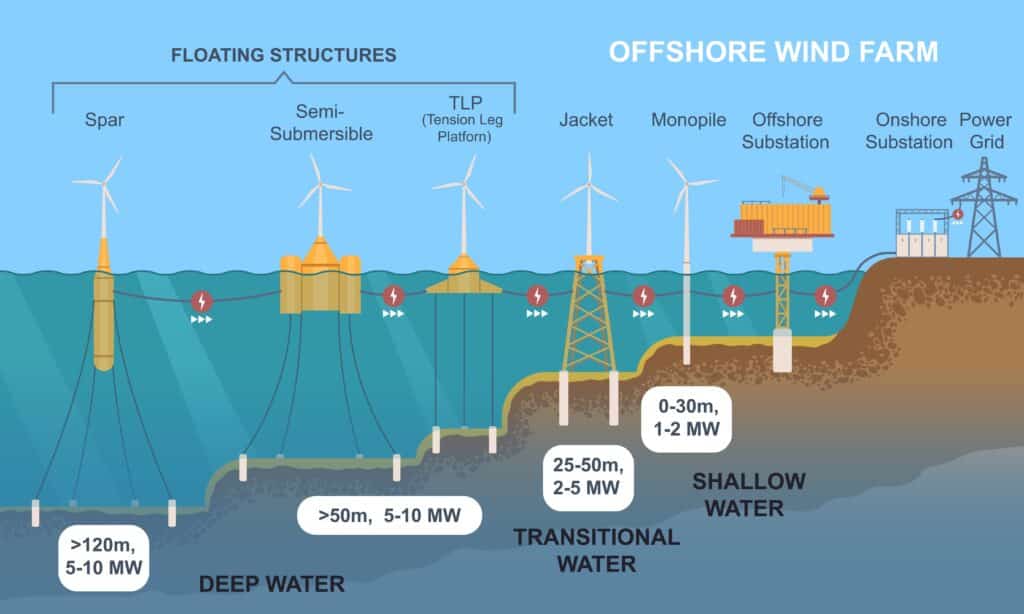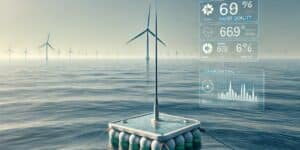Wind power is becoming a crucial component of the global shift to clean energy, offering a sustainable and increasingly affordable path to decarbonization. As this renewable energy source gains importance, the need to harness wind resources in deeper waters has given rise to floating structures. This article provides a detailed look at floating wind technology.
An intricate system for offshore wind power generation
Floating wind, also known as floating offshore wind power, is a method of producing electricity by placing wind turbines on floating structures that are anchored to the seabed. This cutting-edge technology enables the deployment of wind turbines in deeper waters, where traditional fixed-bottom turbines are not feasible due to depth limitations and seabed conditions. To generate this clean energy, a complex system of interconnected components is employed, each playing a vital role.
Floating foundation
The turbines are mounted on platforms that float on the water surface, ensuring stability in the open sea. There are several types of floating platform designs, including spar-buoy, semi-submersible, and tension-leg platforms (TLP), each suited for different sea conditions and depths.
Anchoring and mooring systems
Maintaining optimal performance of floating wind turbines hinges on their stability. Mooring line tension, constantly monitored and adjusted, keeps the platform anchored in place, minimizing its movement. Simultaneously, ballast systems within the platform are dynamically managed, with water weight adjusted to counteract the ever-changing sea conditions. This equilibrium ensures the turbine’s steadfastness and smooth functioning.
Wind turbines
Similar to onshore and traditional offshore wind turbines, these convert wind energy into electrical energy. However, these machines are engineered to endure the ocean’s relentless forces. Their rotor blades intercept the wind’s kinetic energy, spinning with its force. This rotational energy is then transmitted to a generator housed within the turbine’s nacelle. The mechanical energy is then converted into clean electrical power.
Subsea cables
These cables transmit the electricity generated by the turbines directly to an onshore grid or to an offshore substation. These cables are designed to flex with the movement of the floating platform.
Control systems
Advanced control systems are used to monitor and optimize the performance of floating wind turbines. They have three main functions :
- Blade pitch control: adjusting the angle of the blades to maximize energy capture and reduce loads during high winds.
- Yaw control: rotating the nacelle to face the wind direction for optimal energy capture.
- Structural health monitoring: sensors continuously monitor the structural integrity of the turbine and platform to ensure safe operation.
Floating wind, a multifaceted solution for harnessing offshore power
Floating offshore turbines play an increasing role in harnessing wind energy from deeper ocean areas, contributing significantly to the global renewable energy mix.
Access to stronger winds
Thanks to their flexibility, floating wind farms dramatically expand offshore wind potential by giving access to previously untapped ocean areas. Their ability to be positioned in deeper waters with stronger, steadier winds enables significantly more efficient energy generation.
Less environmental impact on seabed
Floating wind turbines have a lower environmental impact on the seabed compared to their fixed-bottom counterparts, making them more compatible with delicate marine habitats. In contrast, the construction of fixed foundations can disrupt the natural homes of sea creatures. Furthermore, the operation of these fixed turbines generates vibrations and underwater noise that can harm marine life.
Reduced visual pollution
Minimized visual pollution is another advantage of floating wind farms. Since they are located far from the coast, they are less visible from shore, preserving coastal landscapes and reducing negative effects to local communities, as well as potential conflicts. This helps in gaining public support for renewable energy projects and facilitates their development.
Complexity and cost, the main challenges of floating wind

While highly promising to unlock the vast potential of deeper ocean winds, generating electricity from floating structures presents a series of challenges.
Technical complexity
Ensuring the stability and durability of floating platforms in harsh marine conditions presents significant engineering challenges. Advanced design and materials are required to withstand strong winds, waves, and corrosive saltwater environments. Moreover, ongoing maintenance and monitoring are essential to ensure these structures’ long-term performance and safety.
Economic factors
The technology is currently more expensive than traditional fixed-bottom turbines due to the complexities of floating structures and anchoring systems. However, technological advancements and economies of scale are expected to decrease costs. Floating wind installations also open up new areas for wind energy exploitation, potentially increasing overall energy yield.
Grid connection
Transmitting power from floating wind farms located far offshore to the onshore grid can be technically challenging and costly. The long distances require advanced subsea cables and grid infrastructure to ensure efficient energy transmission. Additionally, the installation and maintenance of these cables in deep waters add to the overall complexity and expense of the project.
The rise of floating wind power, a promising future for clean energy
Floating wind technology, though still in its infancy, is progressing quickly. In recent years, numerous companies and leading economies have set ambitious targets to expand floating wind installations. Several pilot projects and small-scale commercial setups have been launched globally, with plans for larger commercial ventures on the horizon to provide clean energy to homes or cars.
- The United Kingdom is a pioneer in this sector. Hywind, the world’s first commercial floating wind farm, is a testament to this leadership. Located off the coast of Aberdeenshire in Scotland, the 30-megawatt project represents a significant investment of GBP210 million. Firmly rooted to the seabed in waters reaching depths of 120 meters, the project comprises five wind turbines, each capable of generating six megawatts of power. Operational since 2017, this installation supplies electricity to 22,000 households, resulting in an annual reduction of carbon emissions by 63,000 tons.
- Hywind Tampen, a collection of eleven turbines, stands 140 kilometers from Norway’s coastline, anchored in depths ranging from 260 to 300 meters. This installation is the largest in the world and has a system capacity of 88 MW.
Yet it uniquely supports the energy demands of nearby oil and gas extraction platforms. Equinor, a major Norwegian energy company, estimates that Hywind Tampen will provide up to 35 percent of the yearly electricity requirements for the Snorre A and B, and Gullfaks A, B, and C platforms. This initiative is designed to decrease carbon dioxide emissions from these offshore sites. However, its role in powering the fossil fuel industry has sparked significant debate.
- Beyond these 2, pilot floating wind projects are in operation or development across Europe. Notable examples include France, with installations on both the Mediterranean and Atlantic coasts, and Portugal’s WindFloat Atlantic project.
- In Asia, Japan is leveraging its deep coastal waters in Asia by making significant investments in floating wind technology, which is a key element of its renewable energy strategy. Similarly, South Korea is focusing on the development of floating wind farms in the East Sea to tap into its abundant offshore wind resources.
- In North America, floating wind technology is being explored by the U.S. along the West Coast, especially in California and Oregon, where the depth of the waters presents obstacles to conventional offshore wind farms. The Humboldt Wind Energy Area, a project in the pipeline off the coast of California, is emblematic of this endeavor. The National Renewable Energy Laboratory coordinates R&D efforts to find innovative solutions to energy challenges and accelerate the transition to a clean energy future.
These regions are typically characterized by deep water, strong wind resources, and the commitment of local governments and companies to invest in innovative renewable energy solutions.
FAQ about floating wind
Floating wind technology involves wind turbines mounted on floating structures, allowing them to be placed in deep waters where traditional fixed-bottom turbines are not feasible. These floating platforms are anchored to the seabed and can generate electricity in locations with stronger and more consistent wind resources.
Floating wind turbines operate similarly to traditional wind turbines but are installed on buoyant platforms. These platforms are tethered to the seabed using mooring lines and anchors. The turbines capture wind energy and convert it into electricity, which is then transmitted to shore via underwater cables.
Floating wind farms offer several advantages:
- Access to deeper waters: They can be deployed in deeper waters where wind speeds are higher and more consistent.
- Reduced visual impact: Being located further offshore, they are less visible from the coast.
- Scalability: They open up vast new areas for wind farm development, potentially increasing the total available offshore wind capacity.
Challenges include:
- Higher costs: The technology and materials required for floating platforms are currently more expensive than fixed-bottom structures.
- Technical complexity: Engineering and maintaining floating turbines is more complex due to their location and the need for durable mooring systems.
- Environmental impact: Potential impacts on marine ecosystems and navigation need to be carefully managed.
The future outlook for floating wind energy is promising. Advances in technology and increased investment are expected to reduce costs and improve efficiency. As countries seek to expand their renewable energy portfolios and meet climate goals, floating wind is likely to play a significant role in the global energy transition.


